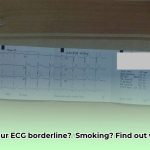Getting an ECG result that’s called “borderline” can be a little scary, especially if you’re older. This article aims to explain what that means in simple terms and what steps you should take next, emphasizing proactive healthcare. For more detailed information on next steps, see this helpful guide: Next steps after ECG. Remember, many borderline ECGs are nothing to worry about, but it’s always a good idea to talk to your doctor about it.
Borderline ECG in Elderly Patients: Unpacking the Results
Getting an ECG result that’s labeled “borderline” can be unsettling, especially for seniors. It means your heart’s rhythm or electrical signals show some minor irregularities. These might be completely harmless, or they could suggest something that needs a closer look. The key takeaway? Further investigation is usually necessary to determine the underlying cause with further monitoring.
Why Borderline ECGs are More Common in Older Adults – Age-Related Heart Changes
Several things make borderline ECG findings more common as we age. Our hearts, like any other organ, naturally change over time. These age-related changes often appear as subtle variations on an ECG. Furthermore, older adults frequently have other health conditions (we call these “comorbidities”) that can influence their heart rhythm. Even the medications someone takes can sometimes show up as minor heart rhythm changes on an ECG. “These subtle variations might stem from temporary factors, such as stress, dehydration, or electrolyte imbalances,” said cardiologist Dr. Sarah Miller, Director of Cardiovascular Health at the Geriatric Medical Center. It’s important to remember that these changes don’t automatically mean something is seriously wrong.
What to Do if Your ECG Shows Borderline Results – Follow-Up Care
First, let’s take a deep breath! A borderline ECG result isn’t necessarily a red flag (warning sign). However, it does need follow-up care. Your doctor will consider several factors—your symptoms (if any), your past medical history, and your overall health to perform complete heart evaluation. They’ll weigh all this information together to figure out what might be going on.
Next Steps After a Borderline ECG: Your Action Plan – Heart Health Management
Here’s a straightforward plan to follow after receiving a borderline ECG. Are you ready to take charge of your heart health and understand the next steps after a borderline ECG result?
- Talk to Your Doctor: This is the most crucial step. Your doctor can explain exactly what the borderline result means in your case and answer all your questions. Don’t hesitate to ask them to explain anything you don’t understand in simple terms.
- Consider Further Tests: Your doctor might recommend additional tests to get a clearer picture of your heart’s health. These could include:
- Holter Monitor: This involves wearing a small device that records your heart rhythm continuously for 24 hours or longer. It helps detect irregular heartbeats that might only occur occasionally, helping assess arrhythmia (irregular heartbeat).
- Stress Test: This assesses how your heart performs under stress (usually during exercise). It helps show whether your heart is getting enough blood flow during activity. There are different types of stress tests, including those that involve walking on a treadmill and those that use medication to simulate exercise.
- Echocardiogram: This uses ultrasound to create images of your heart, allowing doctors to evaluate its structure and function. It can identify valve problems, enlarged heart, or other abnormalities.
- Event Recorder: Similar to a Holter monitor, but worn for a longer period (weeks to months). It records heart activity only when triggered by the patient experiencing symptoms.
- Lifestyle Adjustments Might Be Suggested: Your doctor may recommend some positive changes to support your heart health. This might include improving your diet, adding more regular exercise to your routine, and finding healthy ways to manage stress. Even small changes can make a big difference. A balanced diet, rich in fruits, vegetables, and whole grains, can lower your risk of high blood pressure over time. Aim for at least 150 minutes of moderate-intensity exercise per week.
- Regular Check-Ups Are Key: Follow-up appointments with your doctor are essential, especially given your borderline ECG result. Regular monitoring allows for early detection of any changes and helps ensure your heart health stays on track. These check-ups may include repeat ECGs, blood pressure monitoring, and discussions about any new symptoms.
Understanding the Meaning: Is It Benign or Serious? – Medical Expertise
Most borderline ECG findings in seniors turn out to be entirely harmless. However, some subtle abnormalities can be early indicators of more significant heart issues. Your doctor’s expertise is key in distinguishing between these possibilities. They have the experience to interpret your ECG alongside other factors in your overall health.
Potential Underlying Conditions: What Could It Mean? – Heart-Related Ailments
While a borderline ECG isn’t a diagnosis in itself, it often prompts more investigation, especially if you experience symptoms like:
- Chest pain or discomfort
- Shortness of breath
- Dizziness or lightheadedness
- A racing or irregular heartbeat (palpitations)
- Unexplained fatigue
These symptoms could suggest conditions like coronary artery disease (narrowed arteries reducing blood flow to the heart), heart failure (the heart’s inability to pump blood efficiently), or various types of arrhythmias (irregular heart rhythms). Other potential conditions include electrolyte imbalances and medication side effects..
The Big Picture: It’s Not Just About the ECG – Medical Assessment
Remember, an ECG is just one piece of the puzzle. Your doctor will consider many factors to create a complete picture of your heart health. They’ll combine the ECG results with your symptoms, medical history, family history of heart conditions, and other test results to reach an accurate assessment.
Questions to Ask Your Doctor: Getting the Answers You Need – Proactive Heart Care
Don’t hesitate to ask your doctor any questions that are on your mind. The more you understand, the better you can manage your health. Here are some questions you might want to ask:
- What specifically makes my ECG result “borderline”? Can you show me on the ECG itself?
- What are some of the possible explanations for these findings?
- What additional tests do you recommend—and why those tests specifically?
- What are the potential benefits and drawbacks of these tests?
- What is the likely outcome (prognosis) in my case?
- Are there any lifestyle changes I should make to support my heart health?
- How often should I have follow-up ECGs?
- Are there any medications that could be affecting my ECG results?
- Should I see a cardiologist (heart specialist)?
Taking an active role in understanding your heart health empowers you. Proactive care helps you stay informed and make the best choices for your well-being. Remember, your doctor is your partner in this process.
Understanding Borderline ECG Results in Elderly Patients: How to Interpret Borderline ECG Results and Next Steps
Key Takeaways:
- A borderline ECG isn’t a diagnosis, but a signal for further investigation to assess senior cardiac health issues.
- Many factors—from stress to underlying conditions—can influence ECG readings, showing the importance of understanding ECG variations.
- Your doctor will consider your medical history and symptoms alongside the ECG, to provide an effective diagnostic evaluation.
- Further testing helps determine if the borderline result is significant and to evaluate cardiac risk factors in seniors.
- A heart-healthy lifestyle can improve outcomes promoting cardiac well-being.
What Does a Borderline ECG Mean? – ECG Ambiguity
Have you received a borderline electrocardiogram (ECG) result? It’s understandable to feel a bit anxious. A borderline ECG means the results aren’t clearly normal or abnormal. Think of it like being on the fence—not quite one way or the other. This ambiguity doesn’t automatically signal a serious problem. However, it does mean your doctor needs more information for precise heart diagnosis.
The reason for the uncertainty lies in the subtle variations that can appear on an ECG, necessitating accurate ECG interpretation. These variations might stem from temporary factors, such as stress, dehydration, or even the amount of caffeine you’ve consumed. On the other hand, they could subtly hint at underlying heart conditions or electrolyte imbalances. Specific medications, such as digoxin or some antidepressants, can also affect ECG readings.
How to Interpret Borderline ECG Results and Next Steps: Deciphering the Data – Diagnostic Process
Interpreting how to interpret borderline ecg results and next steps isn’t a simple task. It’s a complex process that relies heavily on your doctor’s expertise. They carefully analyze the ECG tracing, considering its nuances alongside your complete medical history, symptoms, and risk factors, which leads to effective decision making. This holistic view is crucial for accurate interpretation. Did you know that understanding your medical history helps your doctor provide accurate diagnoses? For instance, a history of high blood pressure or diabetes can influence how a borderline ECG is interpreted.
For example, a slight irregularity in your heart rhythm might be insignificant if you’re otherwise healthy and have no symptoms. However, that same irregularity could be concerning if you have a history of heart disease or are experiencing chest pain.
What Happens Next? – Enhanced Cardiovascular Care
Your doctor will guide you through the next steps. This might involve:
- Follow-up appointment: A crucial step to discuss the ECG and your overall health, providing comprehensive patient education.
- Additional tests:
- Wellness Fair Ideas for Work to Boost Employee Wellbeing - December 15, 2025
- Affordable Employee Wellness Fair Ideas for Any Budget - December 14, 2025
- Employee Wellness Programs Strategically Benefit Employee Health And Retention - December 13, 2025
















